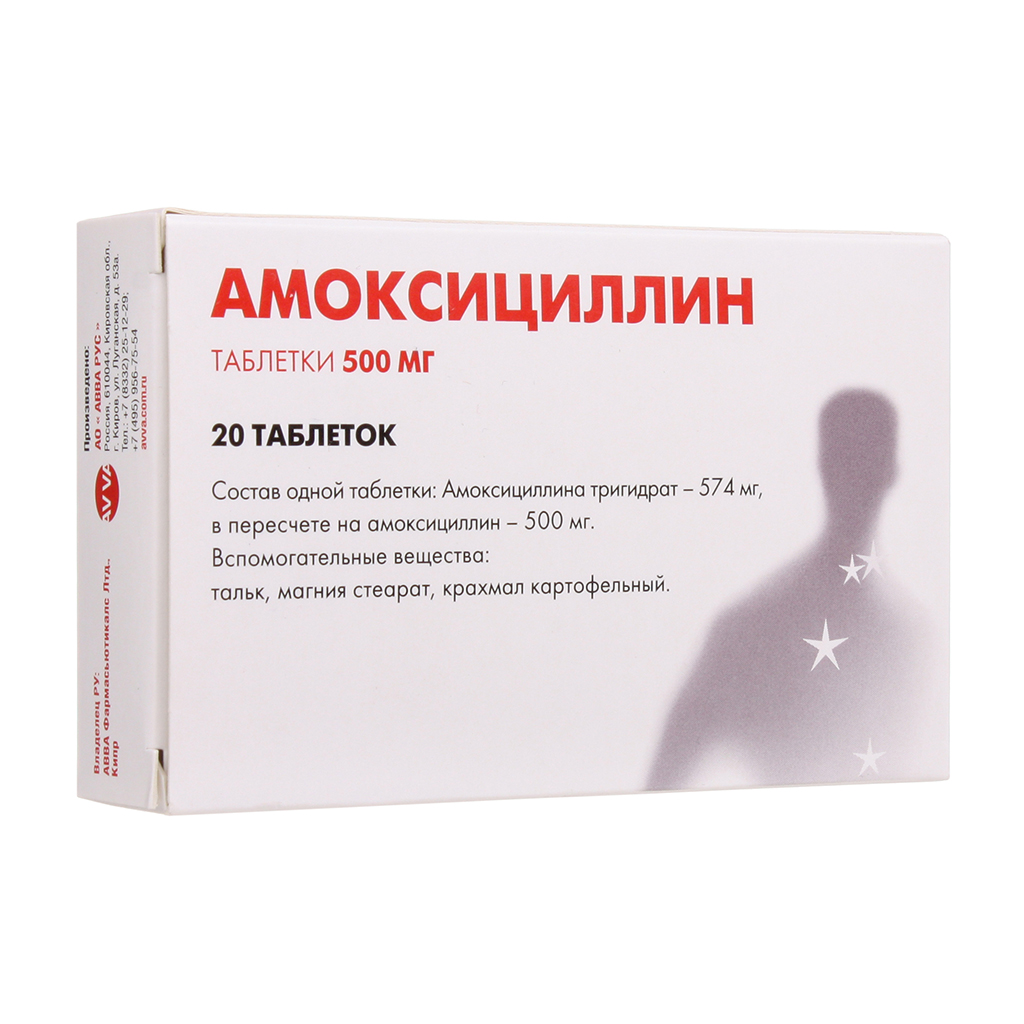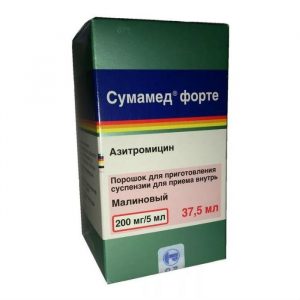Description
Release form
Tablets.
packaging 20 pcs
Pharmacological action
Antibiotic group of semisynthetic broad-spectrum penicillins. It is a 4-hydroxyl analogue of ampicillin. It has a bactericidal effect. Active against aerobic gram-positive bacteria: Staphylococcus spp. (except for strains producing penicillinase), Streptococcus spp aerobic gram-negative bacteria: Neisseria gonorrhoeae, Neisseria meningitidis, Escherichia coli, Shigella spp., Salmonella spp., Klebsiella spp.
Penicillinase-producing microorganisms are resistant to amoxicillin.
In combination with metronidazole is active against Helicobacter pylori. Believe that amoxicillin inhibits the development of resistance of Helicobacter pylori to metronidazole.
Cross-resistance exists between amoxicillin and ampicillin.
The spectrum of antibacterial activity expands with the simultaneous use of amoxicillin and a beta-lactamase inhibitor clavulanic acid. In this combination, amoxicillin activity against Bacteroides spp., Legionella spp., Nocardia spp., Pseudomonas (Burkholderia) pseudomallei increases. However, Pseudomonas aeruginosa, Serratia marcescens, and many other gram-negative bacteria remain resistant.
Indications
For use as monotherapy and in combination with clavulanic acid: infectious and inflammatory diseases caused by susceptible microorganisms, incl. bronchitis, pneumonia, tonsillitis, pyelonephritis, urethritis, gastrointestinal infections, gynecological infections, infectious diseases of the skin and soft tissues, listeriosis, leptospirosis, gonorrhea.
For use in combination with metronidazole: chronic gastritis in the acute phase, peptic ulcer of the stomach and duodenum in the acute phase, associated with Helicobacter pylori.
Contraindications
Infectious mononucleosis, lymphocytic leukemia, severe gastrointestinal infections accompanied by diarrhea or vomiting, respiratory viral infections, allergic diathesis, bronchial asthma, hay fever, hypersensitivity to penicillins and / or cephalic.
For use in combination with metronidazole: diseases of the nervous system, hematopoiesis, lymphocytic leukemia, infectious mononucleosis, hypersensitivity to nitroimidazole derivatives.
For use in combination with clavulanic acid: history of impaired liver function and jaundice associated with taking amoxicillin in combination with clavulanic acid.
Use during pregnancy and lactation
Amoxicillin crosses the placental barrier, excreted in small amounts with breast milk.
If you need to use amoxicillin during pregnancy, you should carefully weigh the expected benefits of therapy for the mother and the potential risk to the fetus.
Use caution with amoxicillin during lactation (breastfeeding).
Composition
Active substance : amoxicillin trihydrate (in terms of amoxicillin lin) – 0.5 g.
Excipients: potato starch, talc, tween-80 (polysorbate-80,) magnesium stearate.
Dosage and administration
Individual. For oral administration, a single dose for adults and children over 10 years of age (with a body weight of more than 40 kg) is 250-500 mg, for severe illness – up to 1 g. For children aged 5-10 years, a single dose is 250 mg at the age of from 2 to 5 years – 125 mg for children under the age of 2 years, the daily dose is 20 mg / kg. For adults and children, the interval between doses is 8 hours. In the treatment of acute uncomplicated gonorrhea – 3 g once (in combination with probenecid). In patients with impaired renal function with a CC of 10-40 ml / min, the interval between doses should be increased to 12 hours with a CC less than 10 ml / min. The interval between doses should be 24 hours.
In case of parenteral administration, adults i / m – 1 g 2 times / day, iv (with normal kidney function) – 2-12 g / day. For children in oil – 50 mg / kg / day, single dose – 500 mg, frequency of administration – 2 times / day in / in – 100-200 mg / kg / day. In patients with impaired renal function, the dose and interval between administrations must be adjusted in accordance with the values of QC.
Side effects
Allergic reactions: possible urticaria, skin hyperemia, erythematous rashes, angioedema, rhinitis, conjunctivitis, rarely – fever, arthralgia, eosinophilia, exfoliative dermatitis, multiforme eksponessa (Stefan’s disease) similar to serum sickness in isolated cases – anaphylactic shock.
From the digestive system: dysbiosis, taste change, vomiting, nausea, diarrhea, stomatitis, glossitis, moderate increase in liver transaminase activity, rarely – pseudomembranous enterocolitis,
From the nervous system: agitation, anxiety, insomnia, ataxia, confusion, behaviors, depression, peripheral neuropathy, headache, dizziness, epileptic reactions.
Laboratory indicators: leukopenia, neutropenia, thrombocytopenic purpura, anemia.
Other: shortness of breath, tachycardia, interstitial nephritis, vaginal candidiasis, superinfection (especially in patients with chronic diseases or reduced body resistance).
Drug Interaction
Pharmaceutically incompatible with aminoglycosides (cannot be mixed to avoid mutual inactivation).
Antacids, glucosamine, laxatives, drugs, foods, aminoglycosides slow down and reduce absorption Ascorbic acid increases absorption. bactericidal antibiotics (including aminoglycosides, cephalosporins, vancomycin, rifampicin) have a synergistic effect bacteriostatic drugs (macrolides, chloramphenicol, lincosamides, tetracyclines, sulfonamides) – antagonistic.
Increases the effectiveness of indirect anticoagulants (suppressing the intestinal microflora, reduces vitamin K synthesis and prothrombin index) decreases the effectiveness of estrogen-containing oral contraceptives in the process of metabolism of which PABK is formed, ethinyl estradiol.
Amoxicillin decreases clearance and increases the toxicity of methotrexate and increases the absorption of digoxin.
Diuretics, allopurinol, oxyphenbutazone, phenylbutazone, NSAIDs, etc. Drugs that block tubular secretion increase the concentration of amoxicillin in the blood.
Allopurinol increases the risk of skin rash.
Overdose
Symptoms: nausea, vomiting, diarrhea, impaired hydro-electrolyte balance (as a result of vomiting and diarrhea).
Treatment: gastric lavage, activated charcoal, salt laxatives, drugs to maintain water-electrolyte balance hemodialysis.
Storage conditions
In a dry, dark place at a temperature of no higher than 25 ° C. Out of the reach of children.
Expiration
2 years.
Active ingredient
Amoxicillin
dosage form
dosage form
tablets
ABBA RUS, Russia


